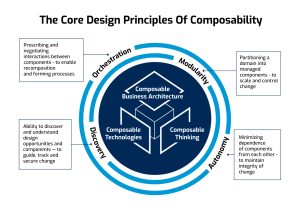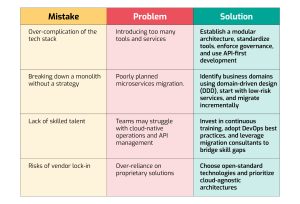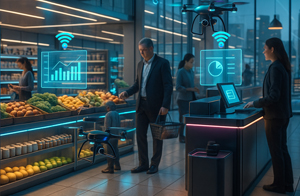Traditional monolithic architectures are holding businesses back, limiting their ability to scale, adapt quickly to market changes, and integrate new technologies seamlessly. In contrast, a composable system allows businesses to innovate and grow. By adopting MACH architecture, organizations can build modular systems that evolve with changing demands—whether it’s integrating AI-driven capabilities, expanding into new markets, or optimizing digital experiences.
In fact, Gartner emphasizes the growing importance of this shift, stating the organizational need to support the accelerating pace of change—businesses will prioritize composable applications that deliver their functionality as API/event-first business components.
Understanding Composable Architecture and MACH

Figure 1: The Core Design Principles of Composability
Composable architecture structures digital capabilities as independent, interchangeable modules, enabling businesses to build, modify, and scale IT systems with minimal disruption. It emphasizes modularity, orchestration, discovery, and autonomy. With this, organizations can seamlessly swap out outdated technologies and integrate new solutions with minimal effort.
MACH is a practical framework that enables such composability in real-world applications. By embracing an API-driven approach, businesses can roll out new features and digital experiences 30–50% faster, reducing time to market and improving responsiveness to customer needs. They also achieve 20–30% cost efficiency by minimizing technical debt, streamlining operations, and optimizing infrastructure. Additionally, MACH enables faster AI adoption and enhanced digital experiences, delivering dynamic, personalized interactions across web, mobile, IoT, and emerging interfaces.
The Role of MACH: The Building Blocks of Composability
With enterprises increasingly prioritizing modular IT architectures, Gartner predicts that by 2027, at least 60% of new digital commerce solutions will align with MACH principles. The MACH architecture framework is built on four key principles:
- Microservices: Breaks down complex applications into smaller, independently deployable services, each handling a specific function. This modular approach enhances flexibility, accelerates development cycles, and allows teams to scale individual components without affecting the entire system.
- API-first: Prioritizes the creation of robust, well-documented APIs to enable seamless communication between services. This ensures smooth third-party integrations, real-time data exchange, and interoperability across different platforms, making applications more adaptable and extensible.
- Cloud-native: Utilizes cloud-based infrastructure to optimize performance, offering automatic scaling, high availability, and cost efficiency through a pay-as-you-go model. By leveraging containerization, serverless computing, and distributed architectures, cloud-native solutions enhance resilience and operational agility.
- Headless: Decouples the front-end presentation layer from the back-end logic, enabling brands to deliver dynamic, personalized experiences across various devices and emerging digital channels. This approach supports faster updates and customization.
The Business Case: Why Composable Architecture Matters
Unlike rigid monolithic systems, composable architecture enables quick adaptation by allowing teams to deploy, modify, or scale individual components without overhauling the entire system.
Beyond efficiency, composable architecture accelerates innovation by fostering a modular, experimentation-friendly environment. It is easier to integrate emerging technologies like AI and real-time analytics, which enable features like personalization to drive customer engagement and retention.
Implementation Roadmap and Challenges
Transitioning to composable architecture unlocks agility, scalability, and innovation. Organizations need a phased approach to navigate technical complexity, data consistency challenges, and cultural shifts to fully realize the benefits of a modular IT ecosystem.
Phase 1: Assessment for Readiness
Adopting a composable architecture begins with a thorough assessment of organizational and technical readiness, determining whether a cloud, on-premises, or hybrid environment best supports scalability, security, and flexibility. Enterprises must be ready to embrace a shift toward cross-functional collaboration, DevOps practices, and a “fail fast” mindset to enable rapid innovation and continuous learning. Additionally, securing stakeholder buy-in from both IT and business leadership is crucial to align objectives and ensure smooth execution.
Phase 2: Planning the Transition
A well-structured transition plan is essential for mitigating risks and avoiding unnecessary complexity. Organizations should:
- Design a microservices architecture with well-defined service boundaries to prevent dependency issues and technical sprawl.
- Establish API management best practices, including authentication and discoverability.
- Assess compliance requirements, including GDPR, HIPAA, and industry-specific regulations, to ensure data security and regulatory adherence.
- Develop a change management strategy to onboard teams, provide necessary training, and create a phased rollout plan for minimal disruption.
Phase 3: Implementation, Governance, and Scalability
With a solid foundation in place, execution must focus on secure deployment, performance optimization, and scalability. Key priorities include:
- Ensuring real-time data synchronization across distributed services to maintain consistency and avoid data silos.
- Implementing governance and security frameworks with clear policies for API authentication, versioning, and role-based access control.
- Scaling infrastructure dynamically to meet business demands.
Phase 4: Continuous Improvement
Composable architecture requires ongoing refinement to stay aligned with business goals and technological advancements. Organizations should:
- Continuously monitor system performance and optimize integrations.
- Foster a culture of iterative development, encouraging teams to experiment with new tools and services to drive continuous innovation.
By following this approach, organizations can mitigate risks, maximize ROI, and future-proof their IT ecosystem. With the market for composable infrastructure projected to reach USD 28.44 billion by 2031, growing at a CAGR of 21.80% from 2024 to 2031, embracing MACH is an imperative for businesses.
Avoiding Common Pitfalls in Composable Architecture
A composable architecture offers flexibility and scalability, but without a well-defined approach, organizations may encounter challenges that slow progress. However, with a pre-migration strategy, organizations can ensure a seamless transition.

Figure 2: Mistakes, Problems, and Solutions in Composable Architecture Adoption.
How Composable Architecture Delivers Measurable Impact?
From transforming dealer networks to streamlining pricing strategies, real-world implementations demonstrate how composability drives business impact.
- Dealer Marketplace Portal for a Leading Automaker
A global automaker built an AI-powered Dealer Marketplace Portal to overcome inefficiencies in inventory, pricing, and order processing. Using composable architecture, the solution enabled a 30% faster order process, 2x quicker feature deployment, and improved dealer satisfaction with self-service and AI-driven search. - AI-Powered Pricing & Packaging for a Manufacturer
A global manufacturer streamlined pricing with an AI-driven engine, integrating real-time ERP and CRM connectivity via an API-first, cloud-native approach. The solution optimized pricing, cut manual efforts by 50%, and boosted revenue by 15–20%, eliminating inconsistencies and revenue leakage. - Cloud-Native Transportation Portal for a State Government
A state government accelerated digital transformation with a composable, cloud-native transportation portal. The solution cut deployment time by 50%, reduced citizen wait times by 30%, and established a scalable foundation for future mobility enhancements.
The Way Forward
Composable architecture is evolving rapidly, with AI/ML enhancing automation, predictive analytics, and decision-making. Meanwhile, low-code and no-code platforms are simplifying application development. Growing vendor partnerships and open-source contributions are expanding specialized microservices, enabling scalable, customized solutions. These advancements are transforming how businesses build and scale digital solutions.
A successful transition starts with assessing the technology landscape and modernizing legacy systems in phases for smoother adoption. Taking it further requires thoughtful planning and practical expertise. With years of experience in seamless implementations, HTC Global Services has been guiding organizations through the complexities of composable architecture with a balanced and strategic approach. Businesses that embrace composability in this manner will be better equipped to innovate, scale, and stay ahead.





